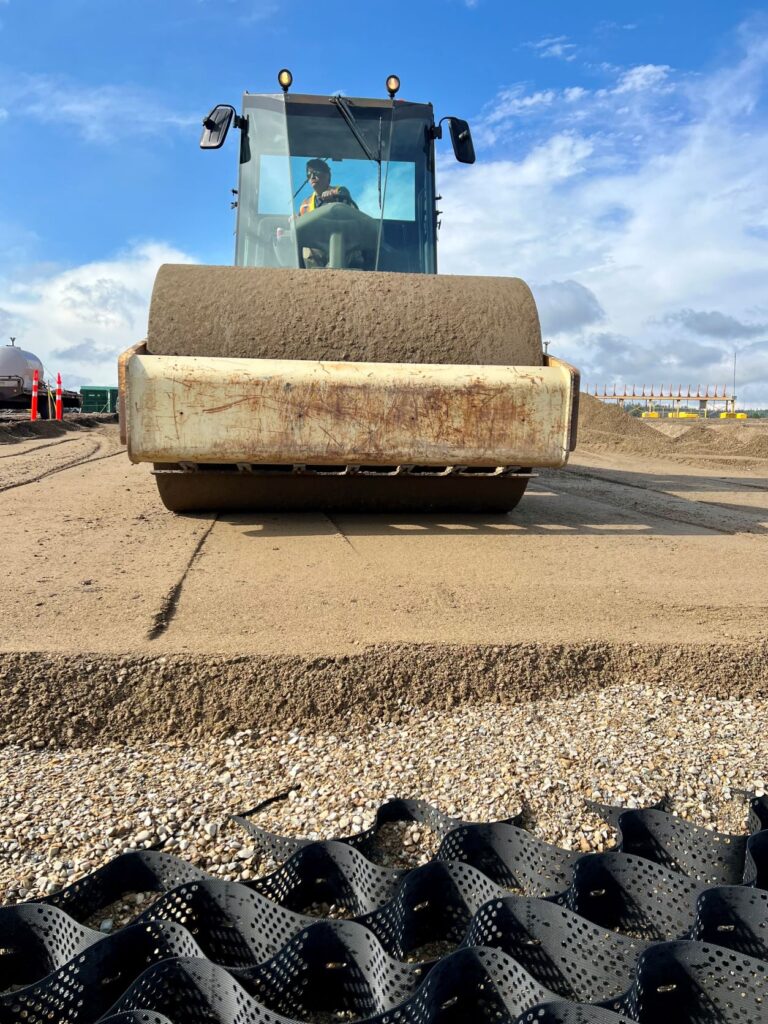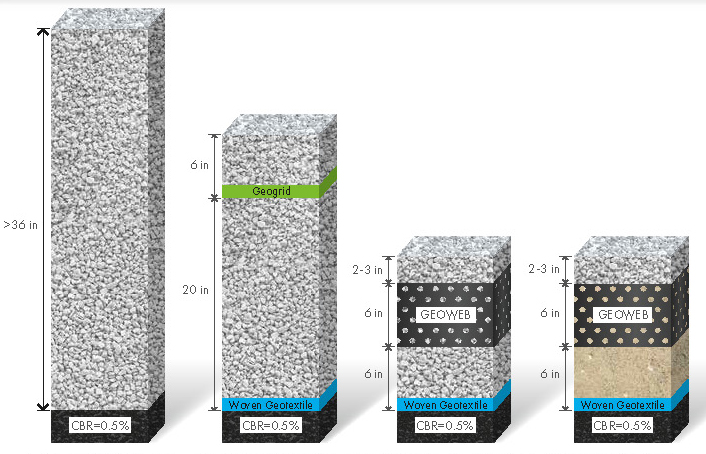
Project Name: Canfor Polar Sawmill Log Yard
Project Location: Bear Lake, British Columbia, Canada
Project Background & Challenges Faced by Sawmill Log Yards
Frequent use of heavy machinery and poor soil conditions at sawmill log yards present serious and costly challenges when it comes to daily operations. Due to remote locations and varying weather conditions, owners must often contend with regular maintenance that can halt operations and stretch budgets.
Such was the case for Canadian Forest Products Ltd (Canfor), which owns and operates the Polar Sawmill in Bear Lake, British Columbia. In the spring and fall, snow melt and rain caused flooding and soft, challenging ground conditions in the infeed area. Drainage issues and rutting not only created unsafe conditions for workers, but also wreaked havoc on machinery, resulting in increased equipment maintenance.
The Solution: The GEOWEB® Soil Stabilization System

To ensure a safe work environment for employees and improve ground conditions for logging machinery, the project owners sought a long-term soil stabilization solution. Canfor had previous success using the GEOWEB System for a similar application at another one of their mills, so they were already familiar with its benefits and began exploring this option for the Polar Sawmill log yard.
Canfor contacted Presto Geosystems, along with local material supplier Layfield Geosynthetics, to provide a preliminary design using the GEOWEB Load Support System. After the initial design phase was complete, a third-party engineer was tasked with preparing the final design to improve operations at the infeed area by addressing drainage issues and soft ground conditions.
One of the biggest design challenges was devising a plan to manage stormwater and snow melt. The engineer called for large rock to be placed below the reinforcement structure of the infeed area to promote stormwater infiltration. The rock was placed between two layers of high-strength geotextile.
The GEOWEB system (6-inch-deep geocells) was installed above the geotextile to confine the crushed aggregate infill and provide a strong reinforcement layer to support frequent heavy loads at the mill infeed area. Through the confinement of infill material, the GEOWEB system eliminates rutting, creating a smooth platform on which machinery can operate.
Project owners and installers appreciated the ease and speed of installation of the GEOWEB panels using the patented ATRA® Key connection device. Engineered for installation speed and connection strength, the ATRA Key is a low-cost, highly effective option for establishing mechanical connections between GEOWEB sections with one quick and easy turn. The ATRA Key is suitable for connecting GEOWEB panels through the panel I-slots, both end-to-end and side-to-side, and is substantially more reliable in terms of establishing consistent mechanical junction strength when compared to other, more rudimentary connection methods, such as staples or zip ties.
GEOWEB System Benefits for Unpaved & Permeable Surfaces
With granular infill, the GEOWEB system provides a cost-effective alternative to hard-surface pavements with many environmental benefits. By confining the infill, the system improves the load distribution characteristics of unpaved roads and pavement areas, thereby reducing long-term maintenance requirements and costs over the life of the project. Additionally, where a green solution is desired, the GEOWEB system may be infilled with a blend of topsoil and aggregate to create a vegetated surface that supports occasional loads.
In most cases, the GEOWEB system can reduce base layer thickness requirements by 50% or more. This not only provides project savings due to the large reduction in imported aggregate requirements, but also results in a significant reduction in transportation- and construction-related emissions. Moreover, at project locations where a suitable source of clean, angular sand is present on-site or nearby, the GEOWEB system allows for the use of this locally available material, resulting in even more savings and protecting against project schedule risks due to trucking delays and aggregate supply chain issues.

As illustrated above, the unreinforced aggregate option would require more than 36 inches of aggregate to achieve minimal stability, and the planar geosynthetic option (geogrid and geotextile) would require 26 inches of aggregate. In contrast, the GEOWEB geocells reduce the total section thickness to only 15 inches. Where suitable on-site material (OSM) is available, it is possible to limit imported aggregate to just the wearing course.










































